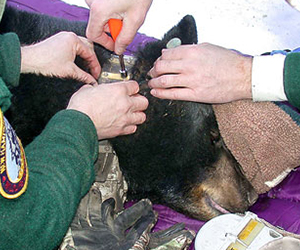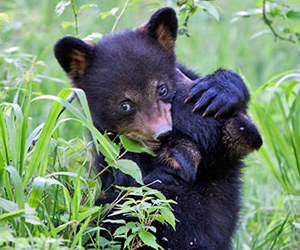Bear Talk
Information On How Black Bears Communicate With Each Other And People

By Ben Kilham, Black Bear Rehabilitator
Bears have no trouble reading us, but we have a hard time understanding them. Like humans, bears communicate and cooperate with strangers. They can deceive, bluff, or manipulate. Ben Kilham shares his insights on what it means when a bear false-charges.
Perhaps the most important thing I’ve learned from bears is how they communicate. This is what is most often misinterpreted by humans. Most of their communication is like our non-verbal emotional exchanges: facial expression, intensity of vocalization, tone, body language, and (in the case of bears), ear position, all of which are generally an honest reflection of mood. Bears have no trouble reading us, but we have a hard time understanding them.

Like humans, bears communicate and cooperate with strangers. They can also deceive, bluff, or manipulate. When bears communicate with intention, they mechanically generate sounds and actions: they chomp their teeth, huff, swat, false-charge, and make a guttural huh, huh, huh sound. The meaning of these sounds and actions varies with the context of the situation.
The false-charge is perhaps the most misunderstood behavior. The bear lunges at another bear or a human, expelling a big blast of air and chomping its teeth. Humans tend to take it literally, thinking that the bear wants to harm us, but nothing could be further from the truth. A false-charge actually signals that they are not going to attack, but rather that they are uncomfortable with the confrontation.

If you are walking quietly on a trail and you come across a sow with young cubs, she may send her cubs up a tree and false-charge you. It is intimidating, but she only wants to delay confrontation so communication can take place. She sees you as the aggressor. Remember, she can read your non-verbal communication, so if you can control your own actions, you can control the interaction. Stand erect, keep your eyes on the bear, and speak softly to it. In 3 to 10 minutes, she will recognize that you are not a threat, and you can safely back away.
The false-charge is often a bear’s way of communicating displeasure, such as when you confront a bear that is trying to get a meal. Or it may be manipulation: if a restaurant worker gets false-charged while carrying a pail of food scraps to a dumpster, the bear simply wants the pail to drop. The false–charge is normal communication between bears. I’ve been false-charged more than a thousand times in the past 25 years. I simply listen to what the bear is trying to say.

Ben Kilham Spotlight
Black Bear Rehabilitator
Black Bear Rehabilitator Ben Kilham is the author of two books: Among the Bears and Out on a Limb and its paperback version, In the Company of Bears. He gives public lectures throughout New England.



